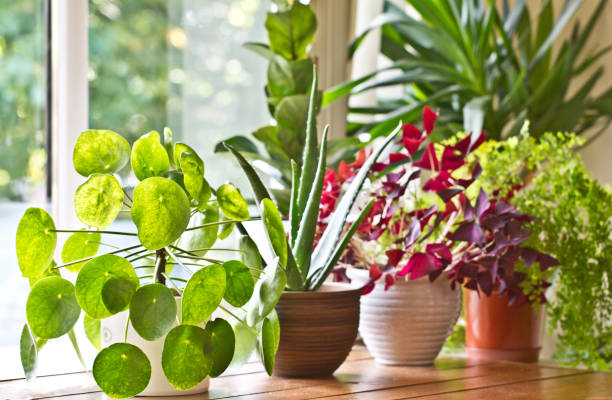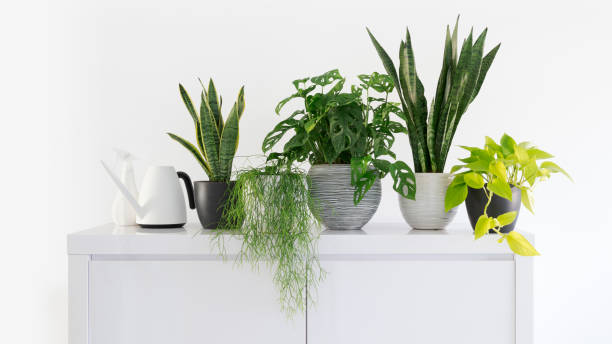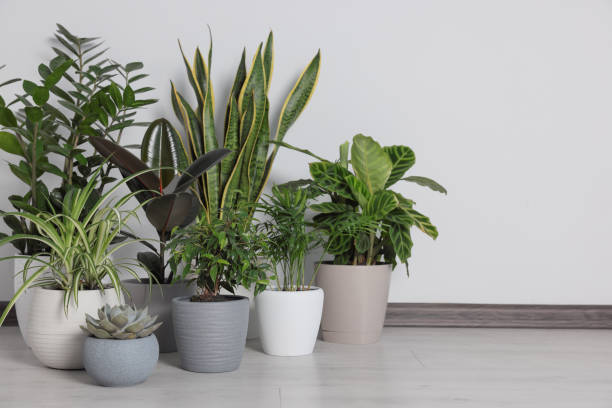Introduction
In today’s busy world, having clean air at home is more important than ever, but we don’t always think about it. With more people living in cities, dealing with pollution, and spending more time indoors, it’s important to make sure the air we breathe at home is fresh and healthy.
The easiest and most natural way to improve the air in your home is to add plants. Indoor plants not only beautify your home, but they also purify the air by removing harmful chemicals, adding oxygen, and making it less dry.
As we move into 2025, more people are using air-purifying plants because they’re good for your health and the planet. From popular choices like the snack plant to new and exciting plant trends, this guide will show you the best indoor plants to make the air in your home clean and fresh.

Why Indoor Plants Are Essential for Air Quality
Indoor plants play a vital role in improving the air quality in our homes and workplaces. Here’s how they help:
Remove harmful toxins.
Plants can absorb harmful chemicals from the air, such as formaldehyde, benzene, and carbon monoxide, which are often found in things like furniture, cleaning products, and paint. In doing so, they make the air safer to breathe.
Produce oxygen.
Through a process called photosynthesis, plants take in carbon dioxide (the air we breathe out) and release oxygen. This helps keep the air fresh and provides us with the oxygen we need to stay healthy.
Increase humidity
Plants release moisture into the air through a process called transpiration. This can help increase the humidity in your home, which is especially helpful in dry environments. High humidity can reduce problems like dry skin, sore throats, and respiratory problems.

Reduce carbon dioxide levels.
Too much carbon dioxide in the air can make you feel tired or dizzy. Plants naturally absorb carbon dioxide, helping to balance the air and keep it comfortable.
Support mental and physical health.
Clean air is good for your overall health, and having plants around can reduce stress and improve mood. When the air is clean, you breathe better, sleep better, and feel more energized.
Top Air-Purifying Plants of 2025
In 2025, many plants are favored for their ability to purify the air and make homes more beautiful. Here are some of the best plants that are easy to care for and are great for improving air quality:
Snake plant (Sansevieria)
Snake plants are super easy to care for and can remove harmful chemicals like formaldehyde and benzene from the air. It grows well in low light and doesn’t need much water, making it a great choice for beginners.
Peace lily (Spathiphyllum)
Peace lily purifies the air and looks beautiful with its white flowers. It helps get rid of toxins like ammonia and trichloroethylene. Keep the soil slightly moist and place it in a spot with indirect sunlight.
Spider Plant (Chlorophytum comosum)
This plant is hardy, grows quickly, and removes chemicals like carbon monoxide and formaldehyde from the air. It needs bright, indirect light and should be watered occasionally.
Areca Palm (Dipsis lutescens)
This large, leafy plant purifies the air and increases humidity, making it great for large spaces like living rooms or offices. Place it in bright, indirect sunlight and water it regularly.
Boston Fern (Nephrolepis exaltata)
Boston ferns are great for adding moisture to the air and removing harmful chemicals like xylene and formaldehyde. They like humid areas and indirect sunlight. Keep the soil moist.
How to Take Care of Air-Purifying Plants
Air-purifying plants are easy to care for if you follow these simple steps:
Watering
Most indoor plants don’t like wet, soggy soil. Check the top of the soil — if it feels dry, it’s time to water. If the leaves are wilting, the plant may need water. If the leaves are turning yellow, you may be watering it too much.
Light needs
Some plants, like snake plants, can thrive in low light. Others, like areca palms, need bright but indirect light. Too much direct sunlight can burn the leaves. Make sure your plant gets soft, dim light instead.

Humidity
Plants like Boston ferns and peace lilies love humid air. You can mist their leaves with water or place a small tray of water near them to add moisture to the air. If your home is dry, especially in the winter, using a humidifier can help your plants stay healthy.
Soil and fertilizer
Use potting soil that drains well so that your plant’s roots don’t sit in water. Garden soil is not a good choice for indoor plants. During spring and summer, add a liquid fertilizer to the soil once a month. Don’t fertilize in the winter, when plants grow slowly.
Pruning and cleaning
If the leaves turn brown or yellow, cut them off to keep your plant looking nice and healthy. Dust on the leaves can block sunlight, so wipe them gently with a damp cloth every few weeks.
Creating an Indoor Plant Sanctuary
An indoor plant shelter is a special area in your home where you can place plants to bring nature inside. It helps to make your space feel calm, fresh, and beautiful. Here’s how to create your plant shelter:
Choose the right location.
Choose a spot in your home that gets plenty of sunlight for your plants, like near a window or in a bright corner. Make sure your plants have plenty of room to grow and look their best.
Choose a variety of plants.
Use a variety of plants to make your space lively and interesting. Pair tall plants like areca palms with shorter plants like peace lilies or Boston ferns. If you have a small area, choose plants that don’t take up too much space, like snake plants or spider plants.
Arrange plants creatively.
Place plants of different sizes in groups. Plant tall plants in the back and smaller plants in the front. Add shelves, plant stands, or hanging pots to make your space look stylish and save room.
Make it cozy
Place a comfortable chair or small bench near your plants so you can relax or read. Use fairy lights, pretty rocks, or colorful pots to make the area cozy and inviting.
Take care of your shelter
Water your plants when needed, clean their leaves, and check for bugs. Remove dead leaves and mist the area to keep your shelter fresh and clean.

Conclusion
Indoor plants are an easy way to make the air in your home cleaner and healthier. In 2025, plants like snake plants, peace lilies, and spider plants will be popular because they help remove harmful chemicals from the air and provide fresh oxygen. They also make your home feel beautiful and calming. Adding these plants to your space will help you breathe better and enjoy a greener home.
Start your plant journey today!
FAQs
Why is indoor air quality important?
Indoor air quality is important because the air inside our homes can contain harmful chemicals that can make us sick. Poor air quality can cause things like headaches, allergies, and fatigue. Plants help purify the air and make it healthier to breathe.
How do indoor plants improve air quality?
Indoor plants help improve air quality by absorbing harmful chemicals, such as formaldehyde and benzene, from the air. They also release oxygen and add moisture to freshen the air, making the air healthier to breathe.
Can I create an indoor plant sanctuary?
Yes! You can create a special plant sanctuary in your home by choosing a spot in your home with plenty of light, choosing a variety of plants, arranging them well, and adding comfortable seating or decorations. This will help your plants grow and improve the air in your home.
How can indoor plants help my health?
Indoor plants help improve your health by purifying the air you breathe. They get rid of harmful chemicals and add oxygen, which can help you feel better, sleep better, and even reduce allergy symptoms.
Are air-purifying plants easy to care for?
Yes, most air-purifying plants are easy to care for. Plants like Snake Plants and ZZ Plants don’t need a lot of water or sunlight, so they’re great for beginners or people with busy schedules.
